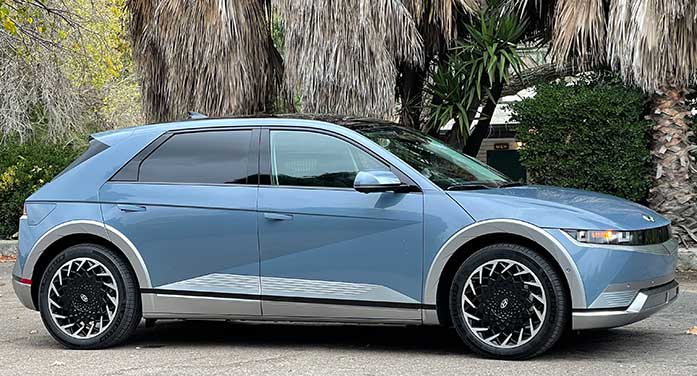
Offered in four varieties, the Ioniq 5 is powered by an “interior permanent magnet synchronous electric motor” that develops 168 to 320 horsepower, depending on the model
 The writing is on the wall. Electric cars are here to stay, becoming more and more abundant. There are at least 16 models available in Canada, and most of the major car manufacturers have something on offer.
The writing is on the wall. Electric cars are here to stay, becoming more and more abundant. There are at least 16 models available in Canada, and most of the major car manufacturers have something on offer.
Hyundai has two fully electric models: the Kona and Ioniq 5. Kia – owned by Hyundai – has another three: Niro, Soul and EV6. They definitely have the bases covered.
I recently drove the Ioniq 5, and it may be my favourite so far.
Offered in four varieties, the Ioniq 5 is powered by an “interior permanent magnet synchronous electric motor” that develops 168 to 320 horsepower, depending on the model. Battery power is a lithium-ion arrangement, and transmission is a single-speed continuously variable setup. You can get the Ioniq 5 in rear-wheel or all-wheel drive.
The Preferred model, which I drove, has a purported range of just over 350 km. The top-of-the-range Preferred Long Range all-wheel-drive model will apparently go almost 500 km between charges, and will scoot from zero to 100 km/h in just over five seconds, says Hyundai. All the other models will do this in about eight or nine seconds. Hyundai also claims a top speed of around 185 km/h for the Ioniq 5.
| RELATED CONTENT | |
| The 2022 Mazda MX-5 remains true to its sports car roots By Ted Laturnus |
|
| Nissan Sentra proves the sedan is still very much alive in 2022 By Ted Laturnus |
|
| Manual version of 2022 Honda Civic Hatchback is your best bet By Ted Laturnus |
|
|
But this isn’t why people drive electric vehicles. This market is all about thrift of operation and environmental awareness. Electric cars can be amazingly quick, but the primary idea is responsible consumerism. The Ioniq 5 embodies that to a T.
You will need to get the fast-recharging unit. If you just plug this car into a conventional 110-volt wall socket at home, it takes its time getting back up to snuff. I had my tester on a plug-in charge for over 10 hours and the recharge rate was almost unnoticeable, from 75 per cent to 78 per cent. At that rate, you’d need to leave it in for a week to get back up to full charge.
As far as power consumption goes, the Ioniq 5 is pretty good. On a typical 30-km trip around town involving city and highway traffic, I dropped from 75 per cent to 68 per cent capacity.
There are three driving modes: Eco, Normal and Performance. I stayed in Normal most of the time, as will most drivers, I suspect.
One small note here: the Ioniq 5 doesn’t creep when you come to a stop and when you hit the throttle to get going again, there’s kind of a lurch – it could be smoother.
The Ioniq 5 has 1,680 litres (60 cubic feet) of storage capacity. Honda’s HR-V offers about the same, so you can carry a fair bit of stuff but it isn’t a workhorse.
Heated front seats are standard on all models, and all but the base version come with a heated steering wheel. A nifty little storage bag hanging from the back of the rear seat contains the recharge cable.
Aside from a rather unusual twist-style shift lever, the Ioniq 5 is easy to get along with. The shift lever is one of those ideas, I suspect, that was built in just to be different.
Ditto with the automatic door handles, which pop out as soon as you hit the unlock button on the key fob. They look cool as hell but are actually kind of awkward. Nothing you wouldn’t get used to, though.
I liked just about everything about the Ioniq 5. I love the styling, got along with the switchgear and ergonomics, appreciated the car’s performance and enjoyed the driving experience.
However, there’s at least a two-year wait to get one of these and the price, at just under $47,000 for the base model – before taxes and extras – is getting up there. There’s a $5,000 federal government rebate, plus various other incentives, depending upon which province you live in. Quebec, for example, will offer up to $13,000 in rebates, while B.C. has up to $8,000 available. Still, you have to really want one of these to shell out the cash.
And you have to be patient.
Ted Laturnus has been an automotive journalist since 1976. He was named Canadian Automobile Journalist of the Year twice and is past president of the Automobile Journalists Association of Canada (AJAC). For interview requests, click here.
The opinions expressed by our columnists and contributors are theirs alone and do not inherently or expressly reflect the views of our publication.
© Troy Media
Troy Media is an editorial content provider to media outlets and its own hosted community news outlets across Canada.

